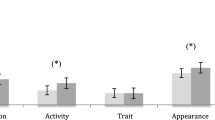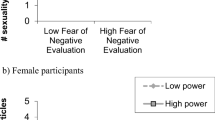Abstract
We explored whether exposure to nonverbal behaviors that mirror those used by men with sexual harassment proclivity (i.e., high dominance and/or high sociosexual nonverbal behaviors) leads women to perceive those men as potential sexual harassers and lowers women's actual performance on the job. In our first experiment, women's performance was negatively affected when they interacted with a task administrator enacting dominant nonverbal behaviors. The women also perceived the dominant task administrator as more sexual. In our second experiment, viewers rated the task administrator enacting dominant nonverbal behaviors as more likely than the less dominant task administrator to show gender-based attention, social attention, and sexually harassing behaviors. Taken together, our findings suggest an association between perceptions of dominance and sexuality.
Similar content being viewed by others
References
Barak, A., & Kaplan, N. (1996). Relationships between men's admitted sexual harassment behaviors and personal characteristics. Unpublished manuscript.
Bargh, J. A., & Raymond, P. (1995). The naÍve misuse of power: Nonconscious sources of sexual harassment. Journal of Social Issues, 51 (1), 85–96.
Baxter, R. H., Jr. (1987). Sexual harassment in the workplace. New York: Executive Enterprises.
Cappella, J. N., & Green, J. O. (1984). The effects of distance and individual differences in arousability on nonverbal involvement: A test of discrepancy-arousal theory. Journal of Nonverbal Behavior, 8 (4), 259–286.
Craig, T. Y., Kelly, J. R., & Driscoll, D. M. (2001). Participant perceptions of potential employers. Sex Roles, 44, 389–400.
Crull, P. (1982). Stress effects of sexual harassment on the job: Implications for counseling. American Journal of Orthopsychiatry, 52, 539–544.
Crull, P. (1984). Sexual harassment and women's health. In W. Chavkin (Ed.), Double exposure (pp. 100–120). New York: Monthly Review Press.
Dovidio, J. F, & Ellyson, S. L. (1982). Decoding visual dominance: Attributions of power based on relative percentages of looking while speaking and looking while listening. Social Psychology Quarterly, 45, 106–113.
Driscoll, D. M., Kelly, J. R., & Henderson, W. L. (1998). Can perceivers identify likelihood to sexually harass? Sex Roles, 38, 557–588.
Duncan, S. (1960). Nonverbal communication. Psychological Bulletin, 72, 118–137.
Exline, R. V., Ellyson, S. L., & Long, B. (1975). Visual behavior as an aspect of power role relationship. In P. Pliner, L. Krames, & T. Alloway (Eds.), Nonverbal communication of aggression (pp. 21–52). New York: Plenum Press.
Fitzgerald, L. F., Collinsworth, L. L., & Harned, M. S. (2001). Sexual harassment. In J.Worell (Ed.), Encyclopedia of women and gender: sex similarities and differences and the impact of society on gender (pp. 991–1004). San Diego, CA: Academic Press.
Garvey, M. S. (1986). The high cost of sexual harassment suits. Personnel Journal, 65, 75–78.
Gruber, J. E. (1992). A typology of personal and environmental sexual harassment: Research and policy implications for the 1990s. Sex Roles, 26, 447–464.
Gutek, B. A. (1985). Sex and the workplace: Impact of sexual behavior and harassment on women, men, and organizations. San Francisco: Jossey-Bass.
Gutek, B. A., & Koss, M. P. (1993). Changed women and changed organizations: Consequences of and coping with sexual harassment. Journal of Vocational Behavior, 42, 28–48.
Harper, R. G. (1985). Power, dominance, and nonverbal behavior: Basic concepts and issues. In S. L. Ellyson & J. F. Dovidio (Eds.), Power, dominance, and nonverbal behavior (pp. 29–48). New York: Springer-Verlag.
Kilpatrick, D. G. (1992, June 30). Treatment and counseling needs of women veterans who were raped, otherwise sexually assaulted, or sexually harassed during military service. Testimony before the U.S. Senate Committee on Veterans' Affairs.
Koss, M. P. (1990). Changed lives: The psychological impact of sexual harassment. In M. Paludi (Ed.), Ivory power: Sexual harassment on campus (pp. 73–92). Albany, New York: State University of New York Press.
Mehrabian, A. (1981). Silent messages. Belmont, CA: Wadsworth.
Murphy, J. D., Driscoll, D. M., & Kelly, J. R. (1999). Differences in the nonverbal behavior of men who vary in the likelihood to sexually harass. Journal of Social Behavior and Personality, 14, 113–128.
Nowlis, V. R. (1965). Research with the Mood Adjective Checklist. In S. S. Tomkins & C. E. Izard (Eds.), Affect, cognition, and personality (pp. 352–389). New York: Springer.
Pryor, J. B. (1987). Sexual harassment proclivities in men. Sex Roles, 17, 269–290.
Pryor, J. B., Giedd, J. L., & Williams, K. B. (1995). A social psychological model for predicting sexual harassment. Journal of Social Issues, 51 (1), 53–68.
Pryor, J. B., LaVite, C. M., & Stoller, L. M. (1993). A social psychological analysis of sexual harassment: The person/situation interaction. Journal of Vocational Behavior, 42, 68–83.
Pryor, J. B., & Stoller, L. M. (1994). Sexual cognition processes in men who are high in the likelihood to sexually harass. Personality and Social Psychology Bulletin, 20, 163–169.
Purdue University Office of Enrollment Management (a). Retrieved April 12, 2005 from Purdue University Student Data Digest Web Site: http://www.purdue.edu/DataDigest/pages/students/stu_age.htm.
Purdue University Office of Enrollment Management (b). Retrieved April 12, 2005 from Purdue University Student Data Digest Web Site: http://www.purdue.edu/DataDigest/pages/students/stu_race.htm.
Rudman, L. A., & Borgida, E. (1995). The afterglow of construct accessibility: The behavioral consequences of priming men to view women as sexual objects. Journal of Experimental Social Psychology, 31, 493–517.
Sadalla, E. K., Kenrick, D. T., & Vershure, B. (1987). Dominance and heterosexual attraction. Journal of Personality and Social Psychology, 52, 730–738.
Simpson, J., Gangestad, S., & Biek, M. (1993). Personality and nonverbal social behavior: An ethological perspective of relationship initiation. Journal of Experimental Social Psychology, 29, 434–461.
United States Merit System Protection Board [USMSPB]. (1987). Sexual harassment in the federal government: An update. Washington, DC: U.S. Government Printing Office.
Wagner, E. S. (1992). Sexual harassment in the workplace: How to prevent, investigate and resolve problems in your organization. New York: Amacom.
Word, C. H., Zanna, M. P., & Cooper, J. (1974). The nonverbal mediation of self-fulfilling prophesies in interracial interaction. Journal of Experimental Social Psychology, 10, 109–120.
Author information
Authors and Affiliations
Corresponding author
Rights and permissions
About this article
Cite this article
Kelly, J.R., Murphy, J.D., Craig, T.Y. et al. The Effect of Nonverbal Behaviors Associated With Sexual Harassment Proclivity on Women's Performance. Sex Roles 53, 689–701 (2005). https://doi.org/10.1007/s11199-005-7734-3
Issue Date:
DOI: https://doi.org/10.1007/s11199-005-7734-3




